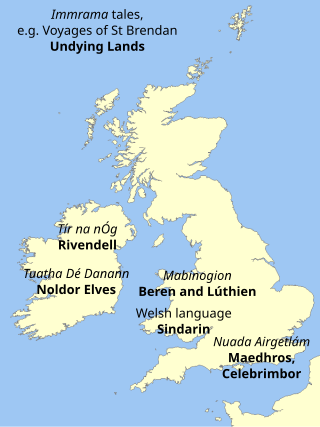Internal timeline

In Tolkien's words:
"Sindarin (Grey-elven) is properly the name of the languages of the Elvish inhabitants of Beleriand, the later almost drowned land west of the Blue Mountains. Quenya was the language of the Exiled High-Elves returning to Middle-earth. The Exiles, being relatively few in number, eventually adopted a form of Sindarin: a southern dialect (of which the purest and most archaic variety was used in Doriath ruled by Thingol). This they used in daily speech, and even adapted their own personal names to its form. But the Sindarin of the High-elves was (naturally) somewhat affected by Quenya, and contained some Quenya elements. Sindarin is also loosely applied to the related languages of the Elves of the same origin as the Grey Elves of Beleriand, who lived in Eriador and further East." [T 11]
Dialects

The divergence of Sindarin (Old Sindarin) begun first into a Northern or Mithrimin group and a Southern group. The Southern group had a much larger territory, and included Doriathrin or "Central Sindarin". [T 12]
"Círdan was a Telerin Elf, one of the highest of those who were not transported to Valinor but became known as the Sindar, the Grey-elves; he was akin to Olwë, one of the two kings of the Teleri, and lord of those who departed over the Great Sea. He was thus also akin to Elwë, Olwë's elder brother, acknowledged as high-king of all the Teleri in Beleriand, even after he withdrew to the guarded realm of Doriath. But Círdan and his people remained in many ways distinct from the rest of the Sindar. They retained the old name Teleri (in later Sindarin form Telir, or Telerrim) and remained in many ways a separate folk, speaking even in later days a more archaic language." [T 13]
So during the First Age, before the return of the Noldor, there were four dialects of Sindarin:
- Sindarin
- Southern group
- Northern group
- North-Western dialect, spoken in Hithlum, Mithrim, and Dor-lómin;
- North-Eastern dialect, spoken in Ard-galen (before its ruin), and the highlands of Dorthonion (Taur-nu-Fuin).
Doriathrin
Doriathrin preserved many archaic features. Unlike the other dialects, it remained free from Quenya influences. The "accent" of Doriath was also quite recognisable, so that after Túrin had left Doriath he kept a Doriathrin accent until his death, which immediately pinpointed his origin to speakers of other dialects of Sindarin. "The post-war 'Beleriandic' as lingua franca and as a language of Noldor was strongly influenced by Doriath." [T 14] Tolkien set out much about Doriathrin morphology, and how it contrasts with the other Sindarin dialects, in his linguistic writings: [T 12]
"Doriathrin preserved in common use the dual of nouns, pronouns, and verbal personal inflexions, as well as a clear distinction between 'general' or 'collective' plurals (as elenath), and 'particular' plurals (as elin). ... But it was none-the-less in a few but important points of phonology marked by changes not universal in Sindarin. Most notable among these was the spirantalizing of m > nasal ṽ, the nasality of which was, however, never lost in Doriathrin proper until after the dissolution of the "Hidden Realm". ... The changes of mp, nt, ñk, also proceeded earlier and further than in the other dialects." [T 12]
Falathrin
The language of the followers of the Elf Círdan, called Falathrin (Falassian in English), is the other dialect of the Southern Sindarin group. It remained close to the tongue of Doriath because there was great trade between the two groups up to the time of the Wars of Beleriand. [T 13]
North Sindarin
North Sindarin was spoken by the Mithrim, the northernmost group of the Grey-elves. It differed from the Central Sindarin of Beleriand in many aspects. Originally spoken in Dorthonion and Hithlum, it contained many unique words and was not fully intelligible to the other Elves. The Northern dialect was in many ways more conservative, and later divided itself into a North-Western dialect (Hithlum, Mithrim, Dor-lómin) and a North-Eastern dialect (the highlands of Taur-nu-Fuin, and the wide plains of Ard-galen to the north of the highlands). This language was at first adopted by the exiled Noldor after their return to Middle-earth at Losgar. Later Noldorin Sindarin changed, much owing to the adoption of Quenya features, and partially because of the love of the Noldor for making linguistic changes. Beren's heritage was clear to Thingol of Doriath as he spoke the North Sindarin of his homeland. [T 15]
"Chief characteristics (of North Sindarin was the) preservation of p, t, k after nasals and l. Intervocalic m remained. No u and o and i/e remained distinct – no a mutation of i. S was unlenited initially. H was preserved medially. tt, pp, kk > t, p, k medially." [T 15]
Noldorin Sindarin
With the exception of Doriathrin, Sindarin adopted some Quenya features after the return of the Noldor, as well as unique sound changes devised by the Noldor (who loved changing languages): [T 16]
"It was the Noldor who in fact stabilized and made improvements to the 'Common Sindarin' of the days of the Wars, and it was based on West Sindarin. The old North dialect practically died out except in place names as Dorlomin, Hithlum, etc. but for a few scattered and hidden clans of the old Northern group and except in so far as adopted by the Fëanorians, who had moved east. So that in the days of the Wars, Sindarin was really divided into 'West Sindarin' (including all the Noldor of Finrod and Fingon), 'East Sindarin' (of the North dialect) was only preserved by the house of Feanor; and 'Central' or Doriath." [T 16]
In the hidden city of Gondolin, an isolated land, a peculiar dialect developed: "This differed from the standard (of Doriath) (a) in having Western and some Northern elements, and (b) in incorporating a good many Noldorin-Quenya words in more a less Sindarized forms. Thus the city was usually called Gondolin (from Q. Ondolin(dë)) with simple replacement of g-, not Goenlin or Goenglin [as it would have been in standard Sindarin]". [T 17]
In the Second and Third Age
'Beleriandic' Sindarin as a lingua franca of all Elves and many Men, and as the language of the Noldor in exile, was based on Western Sindarin but was strongly influenced by Doriathrin. During the Second Age Sindarin was a lingua franca for all Elves and their friends (thus it was used to inscribe the West-gate of Moria), until it was displaced for Men by Westron, which arose in the Third Age as a language heavily influenced by Sindarin. In Gondor at the end of the Third Age, Sindarin was still spoken daily by a few noble Men in the city Minas Tirith. Aragorn, raised in the safety of the Elvish stronghold of Rivendell, [T 18] spoke it fluently. [T 19] [T 20]






